 |
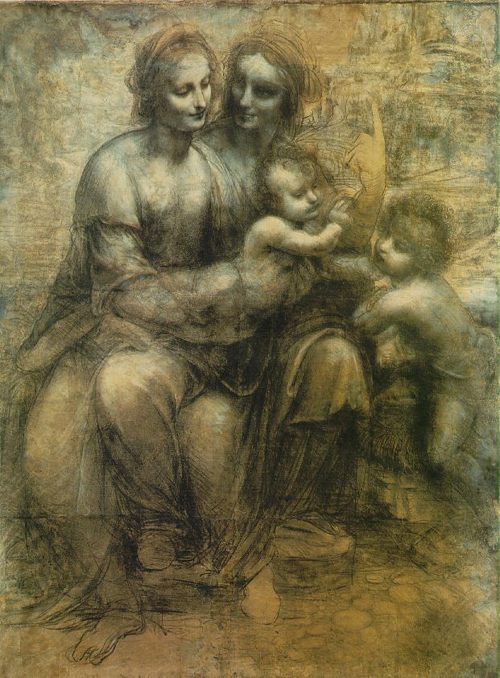 |
 |
"Jomfru
Maria og Jesusbarnet med den hellige Anna
og Johannes Døberen", 1499-1500,
The National Gallery, London.
"The
Virgin and Child with Saint Anne and Saint
John the Baptist", 1499-1500, The
National Gallery, London.
Fotos fra udstilling i
Venedig af Leonardo da Vincis
maskiner,
se nedenfor. |
|
 |
 |
|
Mona
Lisa (La Gioconda), 1503-1506,
Louvre, Paris.
Mona
Lisa (La Gioconda),
1503-1506, Músee
du Louvre, Paris. |
|
|
 |
|
|
|
 |
|
|
 |
Da
Vinci,
Leonardo (Leonardo
di ser Piero da Vinci) (1452-1519).
Italiensk maler, skulptør, arkitekt, ingeniør og
videnskabsmand, aktiv i Firenze og
Milano, født i Vinci nær
Firenze. I 1469, 17 år gammel, rejste Leonardo til
Firenze og kom i lære hos
Andrea Verrocchio, den førende
renæssancemester på
det tidspunkt. I Verrocchios værksted
fik han kendskab til altertavlemaleri, panelbilleder og
fremstilling af store skulpturelle projekter i marmor og
bronze. I 1472 blev han medlem
af malerlauget i Firenze, hvor
han kom i kontakt med andre store kunstnere bl.a.
Michelangelo. I
1482 kom Leonardo i tjeneste som maler og arkitekt hos
hertugen af Milano Lodovico Sforza, og arbejdede for ham de
næste 18 år. Han assisterede den italienske matematiker Luca
Pacioli i arbejdet med "Divina
Proportione" (De guddommelig Proportioner,
Det
gyldne Snit). I denne periode malede han "Den sidste Nadver". I 1499 forlod han Milano og
rejste til Venedig, hvor han fra 1495-99 var
arkitektonisk rådgiver, og fra 1502-03 var han militæringeniør for Cesare Borgia.
I perioden 1503-06 arbejde han
først og fremmest i Firenze, hvor han malede
"Mona
Lisa". I 1509 var han
tilbage i Milano, hvor han brugte
det meste af sin tid på ingeniørarbejde for militæret, videnskabelige studier, matematik, fysik og biologi.
Fra 1514-16 boede han i
Rom under protektion af Pave Leo X, og her kom han igen i
forbindelse med Michelangelo og
Rafael. Han boede i Palazzo Belvedere i
Vatikanet, og menes at have
været optaget af hovedsageligt
videnskabelige eksperimenter.
I 1516 rejste han
til Frankrig og blev arkitektonisk rådgiver hos Kong Frans 1., og han tilbragte sine sidste år på
château
du Clos Lucé, nær ved Amboise, hvor han døde.
Da Vinci var som videnskabsmand og militæringeniør optaget af
teknologi og menneskets anatomi, han dissekerede lig i
det skjulte, ifølge ham selv var det ikke blasfemisk, hvad
det af nogle i tiden blev opfattet som, da han mente, at
verden skulle forstås ved videnskab og ikke
ved religiøse dogmer, han betragtede mennesket som en
maskine. To af da Vincis opfindelser er i dag forsøgt
konstrueret ud fra hans tegninger, det drejer sig om
hans tegninger til en
svæveflyver
(det var hans drøm at flyve) og
en
25 m lang
armbrøst
- han nåede sjældent til
detaljerne i sine projekter,
fordi han blev optaget af noget
andet. Kæmpearmbrøsten var
formentlig tænkt til at blive et
bedre præcisionsvåben end
datidens kanoner, og
inspirationen fandt han i
menneskekroppen, han overførte
kroppens teknik til sine
opfindelser. |
 |
Da
Vinci,
Leonardo
(Leonardo di ser Piero da Vinci)
(1452-1519) Italian
painter, sculptor,
architect, engineer and scientist,
active in Florence and
Milan, born in Vinci near Florence.
In 1469, at the age of 17, Leonardo moved to Florence and
became apprenticed to
Andrea Verrocchio, a leading
Renaissance master of that time. In Verrocchio's workshop he
was introduced to the painting of altarpieces, panel
pictures and to the creation of large sculptural projects in
marble and bronze. In 1472 Leonardo became a member of the
painter's guild of Florence, where he came into contact with
other great artists including
Michelangelo.
In 1482 Leonardo entered the
service of the duke of Milan Lodovico
Sforza for the next 18 years, and
was active also as painter and architect and assisted the
Italian mathematician Luca Pacioli in the work "Divina
Proportione". During this
period he painted "The Virgin of the Rocks" and
"The Last Supper".
In 1499 he left Milan and traveled to
Venice, where he consulted on architecture from 1495-99 and
from 1502-03, he was military engineer for Cesare
Borgia. In the period 1503-06 he first of all worked in
Florence where he painted "Mona Lisa". In 1509
his was back in Milan devoted much of his time to military
engineering, scientific studies such as anatomy,
mathematics, physics and biology. From 1514-16 he lived in
Rome under the patronage of Pope Leo X,
where he came into contact with again Michelangelo and
Raphael.
He was housed in Palazzo Belvedere
in the Vatican and seems to have been occupied principally
with scientific experimentation. In 1516 Leonardo
traveled to France and became architectural advisor to King
Francis I and spent his last years at
château
du Clos Lucé near Amboise, where he died.
Photos from the 2015 Venice exhibition of
Leonardo da Vinci's machines,
see below.
|
|
|
 |
 |
Leonardo da Vincis
Vitruvianske mand
Da Vinci's Vitruvian
Man
Homo
ad circulum et homo ad quadratum |
 |
|
|
|
 |
Leonardo da Vincis tegning gengiver
menneskefiguren i
Homo ad circulum et homo ad quadratum,
hvor mennesket, skabt i Guds billede, kan
indskrives i en cirkel og et kvadrat. Man mente,
at menneskebilledet var opbygget efter
musikalske harmonier. Menneskets fysiske mål var
det centrale. Hele periodens rationelle kultur
opfordrer til gengivelse af virkeligheden
(i modsætning til tidligere tiders mysticisme). |
 |
|
Marcus Vitruvius
Pollio
(80-20 f.Kr.). Romersk forfatter, arkitekt og
ingeniør, studerede menneskets proportioner, og
resultatet af hans studier blev senere til
Leonardo da Vincis "Den Vitruvianske mand".
Vitruvius konkluderede, at et menneske der stod
med ben og arme udstrakt, kunne indskrives i en
cirkel og et kvadrat, centrum af mennesket er
navlen. Vitruvius skrev værket "De architectura
libri decem" (De ti bøger om arkitektur), ca. 27
f.Kr. - de eneste bevarede skrifter om oldtidens
arkitektur - skrifterne inspirerede renæssancens
arkitekter. |
 |
Homo Vitruvianus
is the Proportions of The Human Figure
created in God's
Image.
Marcus Vitruvius Pollio
(80-20 B.C.), Roman writer, architect and
engineer, the author of "De Architectura".
Vitruvius studied human
proportions, and his treatises were later
encoded in Leonardo da Vinci's "Vitruvian
Man". Vitruvius concluded, that a man with
legs and arms outstretched could be inscribed
within the perfect geometric figures of the
circle and the square alike. These two figures
are usually referred to as the
homo ad circulum et homo ad quadratum.
According to Vitruvius' theory, the centre of
the human body as inscribed within the square
and circle coincided with the navel. Vitruvius's
findings were taken up again during the
Renaissance, and best known is the drawing by
Leonardo da Vinci. |
 |
|
Homo
Vitruvianus
ca. 1490.
Da Vinci
signerede
sin
Vitruvianske
mand
LEONARDO
VINCI og
undlod "DA".
|
 |
|
Homo
Vitruvianus
c. 1490.
Da Vinci
signed his
Vitruvian
Man LEONARDO
VINCI
without "DA". |
|
|
|
|
 |
|
|
  |
|
|
 |
|
Den
sidste Nadver/La
Última Cena |
|
Drop Down Menu
|
| Kør
musen over billedet for at se navnene på
personerne. |
|
 |
"Den
sidste Nadver"
(La Última Cena), 1498, hænger
på endevæggen i munkenes spisesal i
kirken Santa Maria delle Grazie, Milano.
Leonardo malede billedet for sin patron,
hertugen Lodovico Sforza, det viser scenen
fra Jesu sidste måltid. Jesu sidste dage,
er beskrevet i
Bibelens fire evangelier. Aftenen før måltidet
var Jesus blevet forrådt af en af sine disciple
(Judas, forræderen). Jesus
samlede sine disciple for at spise og fortalte
dem, hvad der skulle ske og vaskede deres fødder.
Under det sidste måltid gav Jesus sine disciple
anvisninger omkring hvordan de skulle spise og
drikke i fremtiden til erindring om ham. Fodvaskningen symboliserer ydmyghed, at alle er
lige for Herren.
Se
kristne højtider |
"The
Last Supper" (La
Última Cena), 1498,
The refectory in the
Church Santa Maria delle Grazie, Milan.
Leonardo
painted The Last Supper for his patron the Duke
Lodovico Sforza. It represented the scene of The
Last Supper from the final days of Jesus Christ
described in the four Gospels of The Bible. The
evening before Christ was betrayed by one of his
disciples (Judas the Betrayer), he gathered them
together to eat, told them that he knew what was
coming and washed their feet. During The Last
Supper Christ gave his disciples instructions on
how to eat and drink in the future, in
remembrance of him. The Feet Washing symbolized
humility, that all were equal under the eyes of
the Lord.
From left to right: Bartholomew,
James/Jacob, Andrew, Judas Iscariot, who
betrayed Jesus to his enemies for 30 pieces of
silver, Simon, whom Jesus called Peter, John,
Jesus, Thomas (raised his finger), James of
Zebedee, Philip, Simon the Canaanite (called
Simon the Zealot), Jude/Thaddaeus, Matthew.
"Easter in Images. The Last Supper
According to Leonardo" by Sandro Magister
and "If
the Christ of Leonardo were to look up, he would
see the cross" by Timothy Verdon.
Read the text, click
here. |
 |
Santa Maria delle Grazie, Milano
Santa Maria delle Grazie, Milan |
|
|
|
 |
|
|
 |
 |
Den hellige gral/The Holy Grail
Da Vinci mysteriet/The da Vinci Code |
|
 |
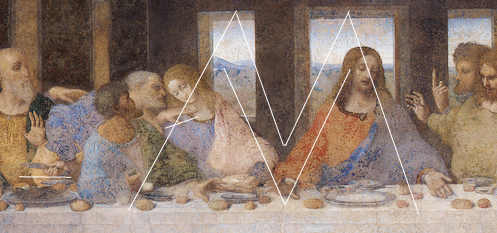 |
 |
Leonardo
da Vinci: Udsnit af "Den sidste
Nadver" (la Ultima Cena), 1498.
Den Hellige Gral indgår som skjult
symbolik, ikke som et fysisk bæger/kalk.
Ifølge Dan Brown er Den Hellige Gral
identisk med
Maria Magdalene, som sidder
til venstre for Jesus. I mellemrummet
mellem Jesus og Maria Magdalene kan
indskrives et "V", gudinden
Venus' symbol, symbolet for kvinden,
således er "V"-formen Den
Hellige Gral og den Hellige Kvinde,
som kirken forviste, som senere er
beskrevet som en hore, og ikke den kvinde,
Jesus giftede sig og fik datteren Sarah
med. "M"-formen står for
Maria Magdalene og omslutter hende og
Jesus. Til venstre i firkanten ses den
herreløse hånd holdende en kniv.
Peter læner sig ind over Maria Magdalene,
hans håndbevægelse tolkes af Brown som
et knivblad, en trussel fra Peter mod
den kvinde Jesus har udpeget til at
videreføre kirken.
Leonardo da Vinci: Detail "The Last
Supper", (la Ultima Cena), 1498.
The Holy Grail is represented by a hidden
symbol, an not a physical chalice. The
space between Jesus and Mary Magdalene
forms the letter "V", an
old symbol for the planet Venus, the
alchemical symbol for woman - the symbol
for The Holy Grail, the Holy woman
(Mary Magdalene), whom the church
banished, an she was later known as a
prostitute and sinner, and not as the
woman who was to married to Jesus and was
three months pregnat at the time of the
Crucifixion.
Mary Magdalene and Jesus form the letter "M"
= Mary Magdalene.
To the left is an extra
hand holding a knife. Peter Leans
against Mary Magdalene, Brown interprets
his gesture as a knife blade, a threat to
the woman Jesus selected to continue his
work. |
|
 |
|
Den Hellige Gral menes at være den kalk som Jesus velsignede da han indstiftede Den
Sidste Nadver. Kalken skulle også være anvendt ved Korsfæstelsen
til at opsamle Jesu blod og derefter bragt til Glastonbury i England af
Josef af Arimatæa. Gralen er også kendt fra sagnene om kong Arthur, hvor
gralen er den genstand, som ridderne af det runde bord stræber efter at
finde.
|
 |
|
The Holy Grail supposed to be the
chalice, blessed by Jesus, and used by him
and his disciples at the Last Supper. The
chalice is said to have been used during
the Crucifixion, it was filled with the
blood of Jesus, and afterwards, by Joseph
of Arimathea, brought to Glastonbury in
England. In the legends of King Arthur the
Knights of the Round Table were sent on a
quest to find the holy grail. |
|
 |
I
Dan Browns bog "Da Vinci Mysteriet"
- fiktion (kriminalroman)
indeholdende visse historiske samt kunst- og
arkitekturhistoriske faktuelle oplysninger spiller da
Vincis "Den sidste Nadver"
en central rolle. Disciplen Johannes til venstre for Jesus tolkes
feminin, og menes at
være Maria Magdalene, der var en af de første, der så den tomme
grav og den første, der så Jesus efter opstandelsen, og
som skulle have fået et
barn med Jesus, datteren Sarah, der påstås at have giftet sig ind i den
franske kongeslægt (de langhårede) merovinger.
I
"Den sidste Nadver" er mellemrummet mellem Jesus
og Johannes (i bogen Maria Magdalene) udlagt som en
bevidst afstand, der skaber et "V" og tolkes som
Den Hellige Gral - San Greal bliver til Sang Real,
kongeligt blod, og dermed hænger det sammen, at den i billedet ikke
fysiske gral er til stede symbolsk og
profeterer det ufødte barns skæbne. Kompositorisk er billedet bygget op
således, at Jesus er
centralt placeret, omkring ham er der er fire grupper af
disciple, grupperne på hver tre personer nærmest Jesus
dækker delvis for hinanden, og grupperne yderst til
venstre og højre er placeret mere frit. "V"-mellemrummet
til venstre for Jesus gentages på hans højre side, her
indgår nogle fagter, men rent kompositorisk bliver
virkningen, at der skabes luft omkring
hovedpersonen, der
er tale om et dynamisk billede og ikke et stift statisk
billede, som kan ses i tidligere versioner. Der
samtales i da Vincis billede, Johannes er
lyttende, hans placering mod venstre er mere
logisk end symbolsk. I nadverbilleder er
Jesus altid fremhævet f.eks. ved sin
størrelse, klædedragt eller glorie, og der
ses også en kompositorisk funktionel
"V"-afstand til ham. Ideen om det feminine
udtryk kan tillægges at Johannes ikke har
skæg (to disciple har ikke skæg i da Vincis
fremstilling), og langt hår med
midterskilning var tidens mandsfrisure. |
|
|
 |
Maria Magdalene bliver betragtet som en væsentlig figur (ifølge det gnostiske
evangelium, gnosis, gr. erkendelse), og fortielsen af hende som discipel skulle
hænge sammen med, at kvinder ikke skal have indflydelse i
kirken.
Det gnostiske Philips Evangelium (fundet i 1945 i Ægypten
sammen med andre skrifter fra 2. og 3. århundrede) er
bedst kendt for verset, hvor Jesus kysser Maria Magdalene
(nogle af evangelierne var angrebet af myrer, derfor
mangler visse ord): |
|
|
"Og ledsageren til ... Maria Magdalene
... elskede
hende mere end alle disciplene, og plejede
ofte at kysse hende på ... De øvrige disciple
... De sagde til ham "Hvorfor elsker du
hende mere end alle os andre?"
Frelseren svarede og sagde til dem,
"Hvorfor elsker jeg ikke dig som hende?
Når en blind mand og en seende begge er
sammen i mørket, er der ingen forskel på
dem. Når lyset kommer, da vil han som ser
se lyset, og han som er blind vil forblive i
mørket."
|
|
|
|
Ifølge Dan Brown har Jesus kysset Maria Magdalena på
munden, imidlertid
betyder det at kysse en hilsen, et helligt kys til dem,
man havde fællesskab med, en helt almindelig hilsen i
antikken, det har ikke noget med det erotiske kys at
gøre.
I bogen bliver direktøren for Louvre Museet i Paris,
Jacques Sauniere, fundet myrdet. Inden han
udåndede, nåede han at tegne en cirkel omkring sig og anbringe sig
efterlignende "Den Vitruvianske Mand".
På
gulvet er der skrevet en mystisk, kodet meddelelse, en hemmelighed, der skal findes svar på.
Professoren i religiøs symbolik
fra Harvard Universitetet Robert Langdon, der
mistænkes for mordet, og Saunieres
barnebarn kryptografen Sophie Neveu indleder en
intens jagt på den hellige gral stærkt forfulgt af
politiet og jaget af Opus Dei. Priory of Sion har
nøglen til gralen og kan afsløre dens hemmelighed,
Opus Dei vil bevare gralens hemmelighed.
Ifølge Dan Brown var Leonardo Da Vinci stormester i
Priory of Sion. |
 |
Dan
Brown's novel "The da Vinci Code" is fiction,
a detective novel, containing some factual information on
history, history of art and history of architecture. Central
to the story is da Vinci's fresco "The Last
Supper" - the disciple (from the spectators point of
view) to the left of Jesus, John, is according to Brown Mary
Magdalene, who saw the empty tomb, and was the first person
who saw the Lord Jesus after his resurrection. Brown puts
forth the idea that Jesus Christ was married to Mary
Magdalene, and she gave birth to their daughter named Sarah,
who married into the first Frank dynasty (the long-haired
Merovings).
In
"The Last Supper" the space between Jesus and John
forms the letter "V", a symbol of the Holy
Grail, the Sangreal (another name for the Holy Grail), Brown
manipulates the San Greal to Sang Real (royal blood) and
with it there is a connection - the holy Grail is
represented symbolic, predicting the destiny of the unborn
child. The so-called "V" space is not something
special, it is a compositional effect, it creates space
around the central figure, Jesus - in the dynamic
composition conversations take place, John is listening, his
placing to the left of Jesus is more logical than symbolic.
The idea about the feminine look of John can be attributed
to his beardless look (two disciples are beardless), and
long hair with centre parting was the male hairstyle at that
time.
In 1945, a set of 52 religious and philosophical texts
written in the 2nd or 3rd century, were found at Nag
Hammadi, Egypt - the Gnostic Gospel of Philip is best known
for a verse that portrays Jesus kissing Mary Magdalene,
(some of the books were attacked by ants):
|
|
"And
the companion of the ... Mary Magdalene. ...
loved her more than all the disciples, and
used to kiss her often on her ... The rest of
the disciples ... They said to him "Why
do you love her more than all of us?" The
Saviour answered and said to them, "Why
do I not love you like her? When a blind man
and one who sees are both together in
darkness, they are no different from one
another. When the light comes, then he who
sees will see the light, and he who is blind
will remain in darkness." |
|
|
|
According
to Dan Brown, Jesus kisses Mary Magdalene on the mouth,
however a kiss was a common greeting between Master and
disciple - a customary greeting in the ancient world, it has
nothing to do with an erotic kiss.
In "The Da Vinci Code", the curator of the Louvre
Museum, Jacques Sauniere, has been murdered, and before he
expired, he draw a circle around his body and placed himself
like "The
Vitruvian Man",
on the floor was written a mysterious coded message, a
secret demanding an answer. The professor of religious
symbology at Havard University Robert Langdon, who is
suspected of the murder of Sauniere, and Sauniere's
granddaughter the cryptographer Sophie Neveu began their
search for the Holy Grail chased by the police and hunted by
Opus Dei. According to Dan Brown Leonardo Da Vinci was a
Grandmaster of Priory of Sion.
|
 |
|
|
|
|
 |
|
|
|
1 |
"Bebudelsen",
ca. 1472-1475,
Galleria degli Uffizi, Firenze/"The
Annunciation", c. 1472-1475,
Galleria degli Uffizi, Florence. |
|
2 |
Studier
af arme og hænder, 1474, The
Royal Collection, London/Study
of arms and hands, 1474, The Royal Collection, London. |
|
3 |
"Grottemadonna",
1483-86, Louvre, Paris/"The
Virgin of the Rocks",
1483-86, The Louvre, Paris. |
|
4 |
"Kvinde med en hermelin" alias "Portræt af Cecilia Gallerani", omkr. 1493-1490, Nationalmuseet, Krakow.
"The Lady with an Ermine" aka "Portrait of Cecilia Gallerani", about 1493-1490, National Museum, Krakow. |
|
5 |
"Johannes
Døberen", 1513-16, Louvre, Paris/"St
John the Baptist", 1513-16,
The Louvre, Paris. |
|
  |
 |
Leonardo
da Vincis maskiner
udstilling af
reproduktioner 2015 i Venedig i kirken Skt.
Barnabas (Chiesa di San
Barnaba)
Leonardo da Vinci's
machines
exhibition
of reproductions 2015 in Venice in the church of San
Barnaba
(Chiesa di San Barnaba) |
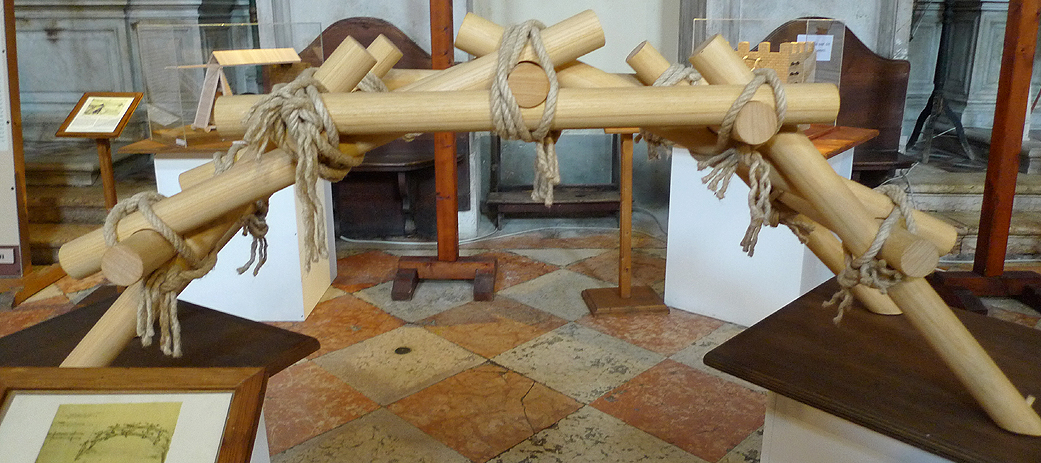 |
 |
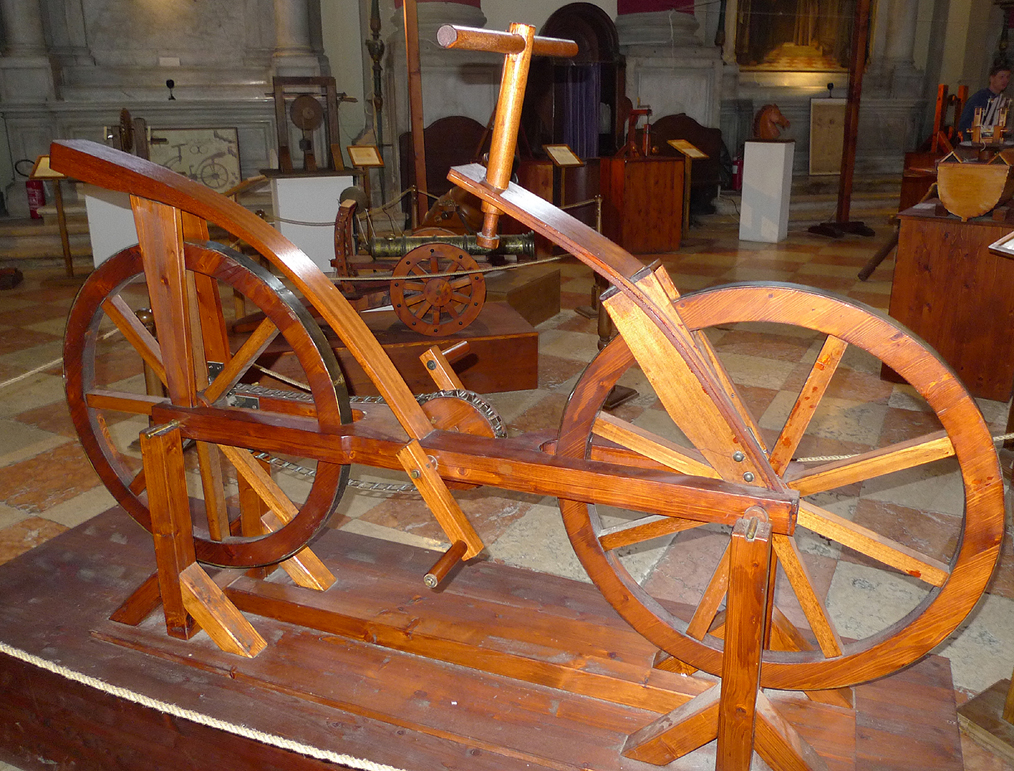 |
|
 |
|
|
|
|
 |
.jpg) |
Baskevinge.
Flapping wing. |
|
|
 |
.jpg) |
Skrueformet mekanisme.
Helical mechanism.
|
|
 |
.jpg) |
Damphammer.
Cam Hammer.
|
|
 |
.jpg) |
Gravemaskine.
Excavating machine. |
|
 |
.jpg) |
Bombekaster.
Bombard. |
|
 |
.jpg) |
Hvordan man kan gå på vandet.
Way to walk on the water. |
 |
|
 |
.jpg) |
Brandstige.
Scaling ladder.
|
|
 |
.jpg) |
Faldmåler.
Clinometer. |
|
|
|
 |
.jpg) |
Svæveplan.
Glider. |
|
 |
.jpg) |
Baskevinge.
Flapping wing. |
|
 |
.jpg) |
Flyvemaskine.
Flying machine. |
|
 |
.jpg) |
Drageflyver.
Hangglider. |
|
|
|
|
|
|
 |
.jpg) |
Artellerikanon.
Artillery Gun.
|
|
 |
.jpg) |
Båd med le.
Boat with scythe. |
|
 |
.jpg) |
Projektør.
Floodlight. |
|
 |
.jpg) |
Buebro.
Arched bridge. |
|
|
 |
.jpg) |
Gearstang.
Gearshift. |
|
 |
.jpg) |
Vægt med trisser.
Weights with pulleys . |
|
 |
.jpg) |
Selvlukkende mekanisme
.
Auto lock mechanism. |
 |
|
 |
.jpg) |
Leonardos hest.
The horse of Leonardo. |
|
 |
.jpg) |
Hestehoved.
Horse Head. |
|
|
 |
.jpg) |
Centralplan,
ottekantet kirke.
Octogonal church with a
central plan. |
 |
|
|
 |
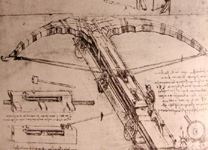 |
Tegning
af kæmpe armbrøst, ca. 1485-87.
Drawing
of giant crossbow, c.
1485-87. |
|
 |
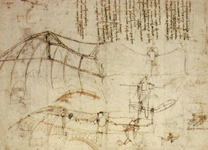 |
Plantegning
af flyvemaskine, ca. 1488.
Design
for a flying machine, c. 1488.
|
|
|
 |
|
Drop Down Menu
|
 |
|

